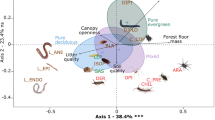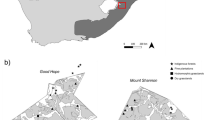Abstract
This work addresses the driving factors responsible for patterns in the detritivore macrofaunal communities of a managed beechwood chronosequence (28 to 197 years old, Normandy, France). We investigated the variation patterns of density, biomass and diversities of detritivore macrofauna throughout this rotation. Multivariate analyses were carried out to identify the main covariation patterns between species and some properties of their physical environment, and to describe the main ecological gradients constraining the macro-invertebrate community assembly. A total of 6 earthworm, 6 woodlouse and 7 millipede species were found in the whole data set. Density, biomass and diversity were profoundly influenced by forest ageing, mainly because of variation in humic epipedon spatial variability. Three groups of species were identified according to their environmental requirements. Some hypotheses regarding the external (related to management practices) or internal (related to inter-specific interactions) assembly rules behind species assemblages are proposed, an approach which has rarely been used in soil ecology. Finally, the impact of forestry practices on soil functioning through their impact on detritivore macro-invertebrate communities is discussed.
Résumé
Ce travail a pour but d’identifier les facteurs responsables des schémas de variation des communautés de la macrofaune detritivore d’une chronoséquence (28 à 197 ans) de futaie régulière de hêtre (Normandie, France). Les modèles de variation de la densité, la biomasse et la diversité ont été recherchés. Les modèles de covariation entre les espèces et certaines propriétés physiques du milieu ainsi que les gradients écologiques qui contraignent les assemblages de macro-détritivores ont été décrits à l’aide d’analyses multivariées. En tout, 6 espèces de vers de terre, 6 espèces d’isopodes et 7 espèces de diplopodes ont été identifiées. La maturation du peuplement de hêtre, principalement par les modifications de l’épisolum humifère, influence fortement les densité, biomasse et diversité. Trois groupes d’espèces sont identifiés sur la base de leurs exigences environnementales. Quelques hypothèses sont proposées quant aux règles externes (liées aux pratiques sylvicoles) et internes (liées aux relations interspéciques) qui contraignent la composition des assemblages d’espèces, cette approche ayant jusqu’à présent été peu utilisée en écologie du sol. Enfin, l’impact des pratiques sylvicoles sur le fonctionnement du sol, au travers de leur impact sur les communautés de macro-détritivores, est discuté.
Similar content being viewed by others
References
AFES, A sound reference base for soils, INRA Editions, Paris, 1998.
Alard D., Poudevigne I., Diversity patterns in grasslands along a landscape gradient in north-western France, J. Veg. Sci. 11 (2000) 287–294.
Arpin P., David J.F., Guittonneau G.G., Kilbertus G., Ponge J.F., Vannier G., Influence du peuplement forestier sur la faune et la microflore du sol et des humus. I. Description des stations et étude de la faune du sol, Rev. Ecol. Biol. Sol 23 (1986) 89–118.
Arpin P., Ponge J.-F., Faille A., Blandin P., Diversity and dynamics of eco-units in the biological reserves of the Fontainebleau forest (France): contribution of soil biology to a functional approach, Eur. J. Soil Biol. 34 (1998) 167–177.
Aubert M., Alard D., Bureau F., Diversity of plant assemblages in managed temperate forests: a case study in Normandy (France), For. Ecol. Manage. 175 (2003) 321–337.
Aubert M., Hedde M., Decaëns T., Bureau F., Margerie P., Alard D., Effects of three canopy on earthworms and other macro-invertebrates in beech forests of Upper Normandy (France), Pedobiologia 47 (2003) 904–912.
Aubert M., Margerie P., Ernoult A., Decaens T., Bureau F., Variability and heterogeneity of humus forms at stand level: comparison between pure beech and mixed beech-hornbeam forest, Ann. For. Sci. 63 (2006) 177–188.
Augusto L., Ranger J., Binkley D., Rothe A., Impact of several common tree species on forest fertility, Ann. For. Sci. 59 (2002) 233–253.
Baker G., Lee K.E., Earthworms, in: Carter M.R. (Ed.), Field samplings and methods of analysis, Lewis Publishers, Boca Raton, 1993, pp. 359–371.
Balent G., Construction of a reference frame for studying changes in species composition in grasslands: the example of an old field succession, Options Medit. 15 (1991) 73–81.
Ballard T.M., Impacts of forest management on northern forest soils, For. Ecol. Manage. 133 (2000) 37–42.
Bengtsson J., Nilsson S.G., Franc A., Menozzi P., Biodiversity disturbances ecosystem function and management of European forests, For. Ecol. Manage. 132 (2000) 39–50.
Beniamino F., Ponge J.F., Arpin P., Soil acidification under the crown of oak trees. I. Spatial distribution, For. Ecol. Manage. 40 (1991) 221–232.
Bergès L., Chevallier R., Dumas Y., Franc A., Gilbert J.-M., Sessile oak (Quercus petrae Liebl.) site index variations in relation to climate, topography and soil in even-aged high-forest in northern France, Ann. For. Sci. 62 (2005) 391–402.
Bernier N., Ponge J.F., Dynamique et stabilité des humus au cours du cycle sylvogénétique d’une pessière d’altitude, C.R. Acad. Sci. Paris, Série III 316 (1993) 647–651.
Bernier N., Ponge J.F., Humus form dynamics during the silvigenetic cycle in a mountain spruce forest, Soil Biol. Biochem. 26 (1994) 183–220.
Blower J.G., Millipeds and centipeds as soil animals, in: Kevan K.M. (Ed.), Soil biology, Butterworths, 1955, pp. 138–151.
Bouché M., Lombriciens de France, Écologie systématique, INRA Éditions, Paris, 1972.
Brêthes A., Catalogue des stations forestières du nord de la Haute-Normandie, ONF, Paris, 1984.
Branquart E., Kime R.D., Dufrêne M., Tavernier J., Wauthy G., Macroarthropod-habitat relationships in oak forests in south Belgium. I. Environment and communities, Pedobiologia 39 (1995) 243–263.
Caley M.J., Schluter D., The relationship between local and regional diversity, Ecology 78 (1997) 70–80.
Chauvat M., Soil biota during forest rotation: Successional changes and implications for ecosystem performance, Ph.D. thesis, Justus-Liebig-Universităt Gießen.
Chauvel A., Grimaldi M., Barros E., Blanchart E., Desjardins T., Sarrazin M., Lavelle P., Pasture damage by an Amazonian earthworm, Nature 398 (2000) 32–33.
Chessel D., Lebreton J.D., Prodon R., Mesures symétriques d’amplitude d’habitat et de diversité intra-échantillon dans un tableau espèces-relevés: cas d’un gradient simple, C.R. Acad. Sci. Paris série III 295 (1982) 83–90.
Chollet F., La régénération naturelle du Hêtre, Bulletin Technique ONF, 32 (1997) 15–25.
David J.F., Relations entre les peuplements de diplopodes et les types d’humus en Forêt d’Orléans, Rev. Ecol. Biol. Sol 24 (1987) 515–525.
David J.F., Les peuplements de Diplopodes d’une forêt tempérée: variations spatiales et stabilité dans le temps, Rev. Ecol. Biol. Sol 26 (1989) 75–90.
David J.F., Ponge J.F., Delecour F., The saprophagous macrofauna of different types of humus in beech forests of the Ardennes (Belgium), Pedobiologia 37 (1993) 49–56.
Decaëns T., Bureau F., Margerie P., Earthworm communities in a wet agricultural landscape of the Seine Valley (Upper Normandy, France), Pedobiologia 47 (2003) 479–489.
Deleporte S., Changes in earthworm community of an acidophilous lowland beech forest during a stand rotation, Eur. J. Soil Biol. 37 (2001) 1–7.
Demange J.M., Les milles-pattes Myriapodes, Boubée, Paris, 1981.
Diamond J.M., Assembly of species community, in: Cody M.L., Diamond J.M. (Eds.), Ecology and evolution of communities, Harvard Univ. Press, 1975, pp. 342–444.
Edney E.B., Woodlice and the land habitat, Biol. Rev. 29 (1954) 185–219.
FAO, ISSS and ISRIC, World reference bases for soil resources, Rome, 1998.
Falinski J.B., Vegetation dynamics in temperate lowland primeval forest, Ecological studies in Bialowieza forest, Geobotany 8 (1986) 15–37.
Franklin J.F., Preserving biodiversity: Species, ecosystem or landscapes? Ecol. Appl. 3 (1993) 202–205.
Hopkins S., A key to the woodlice of Britain and Ireland, Field studies, 7 (1991) 599–650.
Lavelle P., Spain A.V., Soil Ecology, Kluwer Academic Publishers, Dordrecht, 2001.
Lindenmayer D.B., Factors at multiple scales affecting distribution patterns and their implications for animal conservation — Leadbeater’s Possum as a case study, Biodiv. Conserv. 9 (2000) 15–35.
Makeschin F., Earthworms (Lombricidae: Oligochæta): important promoters of soil development and soil fertility, in: Benckiser G. (Ed.), Fauna in soil ecosystems, Marcel Dekker, New York, 1997, pp. 173–223.
Mayer P., Brang P., Dobbertin M., Hallenbarter D., Renaud J.-P., Walthert L., Zimmermann S., Forest storm damage is more frequent on acidic soils, Ann. For. Sci. 62 (2005) 303–311.
Molfetas S., Étude d’un écosystème forestier mixte. VIII. Les Isopodes, Rev. Ecol. Biol. Sol 19 (1982) 427–438.
Palmer M.W., The estimation of species richness by extrapolation, Ecology 71 (1990) 1195–1198.
Ponge J.F., Delhaye L., The heterogeneity of humus profiles and earthworm communities in a virgin beech forest, Biol. Fertil. Soils 20 (1995) 20–24.
Ponge J.F., André J., Zackrisson O., Bernier N., Nilsson M.C., Gallet C., The forest regeneration puzzle, Bioscience 48 (1998) 523–528.
R Development Core Team, R: A language and environment for statistical computing, R Foundation for Statistical Computing, Vienna, Austria, 2004. http://www.R-project.org.
Schaefer M., Schauermann J., The soil fauna of beech forests: comparison between a mull and a moder soil, Pedobiologia 34 (1990) 299–314.
Scheu S., Falca M., The soil food web of two beech forests (Fagus sylvatica) of contrasting humus type: stable isotope analysis of a macro- and a mesofauna-dominated community, Oecologia 123 (1999) 285–296.
Scheu S., Schlitt N., Tuinov A.V., Newington J.E., and Helfin T.J., Effects of the presence and community composition of earthworms on microbial community functioning, Oecologia 133 (2002) 254–260.
Schnitzer S.A., Carson W.P., Have we forgotten the forest because of the trees? Trends Ecol. Evol. 15 (2000) 375–376.
Smith B., Wilson J.B., A consumer’s guide to evenness indices, Oikos 76 (1996) 70–82.
Sohlenius B., Influence of clear-cutting and forest age on the nematode fauna in a Swedish pine forest soil, Appl. Soil Ecol. 19 (2002) 261–277.
Sørensen T., A method of establishing groups of equal amplitude in plant sociology based on similarity of species content and its application to analysis of the vegetation on Danish commons, Biol. Srk. 5 (1948) 1–34.
Thioulouse J., Chessel D., A method for reciprocal scaling of species tolerance and sample diversity, Ecology 73 (1992) 670–680.
Thioulouse J., Dufour A.B., Chessel D., ade4: Analysis of Environmental Data: Exploratory and Euclidean methods in Environmental sciences, R package version 1.3-3, 2004.
Vandel A., Isopodes terrestres (2 vol.), Paul Lechevallier, Paris, 1960.
Weiher E., Keddy P., Assembly rules as general constraints on community composition, in: Weiher E., Keddy P. (Eds.), Ecological assembly rules. Perspectives advances retreats, Cambridge University Press, Cambridge, 1999, pp. 251–271.
Author information
Authors and Affiliations
Corresponding author
Rights and permissions
About this article
Cite this article
Hedde, M., Aubert, M., Bureau, F. et al. Soil detritivore macro-invertebrate assemblages throughout a managed beech rotation. Ann. For. Sci. 64, 219–228 (2007). https://doi.org/10.1051/forest:2006106
Received:
Accepted:
Issue Date:
DOI: https://doi.org/10.1051/forest:2006106




